|
BOTTICELLI - THE BIRTH OF VENUS - PAGE
2
|
Searching for the True Author |
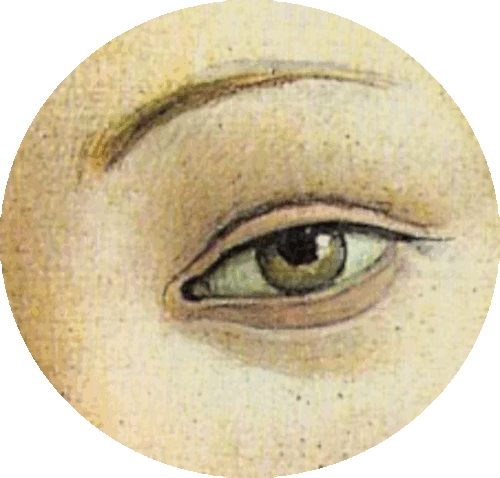
Eye opening |
- There are questions arising about
whether it was Botticelli that created Birth of Venus
and Primavera, or if it was Leonardo DaVinci.
- Before 1550,
art historian Giorgio Vasari documented that both paintings
were situated in the Villa di Castello outside Florence
where they were associated with Lorenzo Medici, il Magnifico.
- Otherwise known as Lorenzo the Magnificent of the
powerful banking, church and ruling family in Florence in the
early 16th-century.
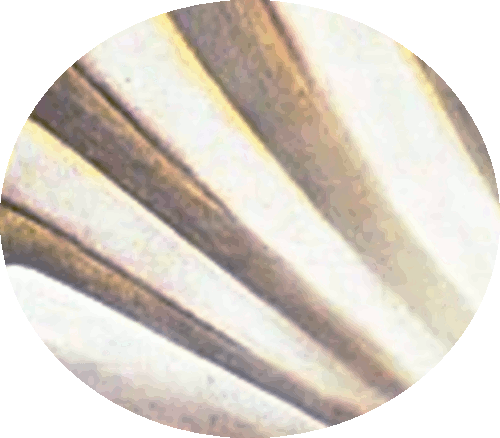
Country home |
- By 1815, because of their location, both paintings were attributed to Sandro Botticelli, who
worked for the Medici, and accordingly, they were placed close by in the Uffizi Gallery
in Florence.
- At that time there was no evidence who painted them, other than a rumor
that
they were painted for a Medici wedding and intended to
decorate a country home.
|
e |
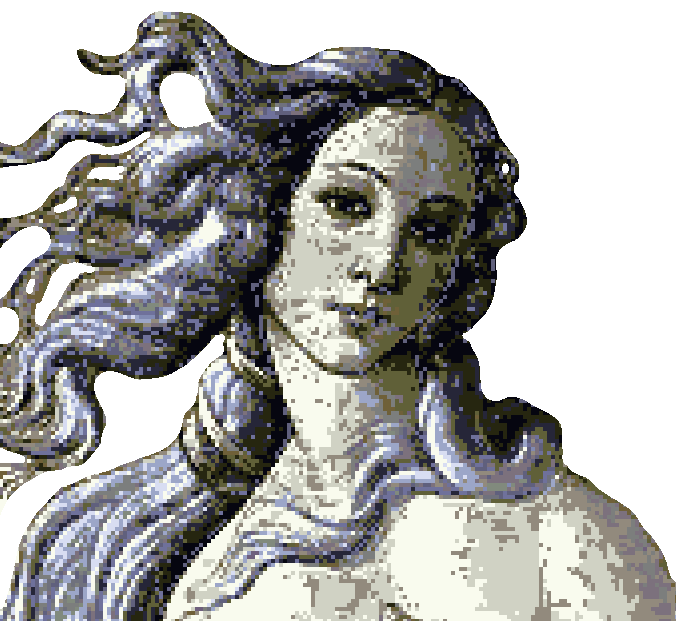 |
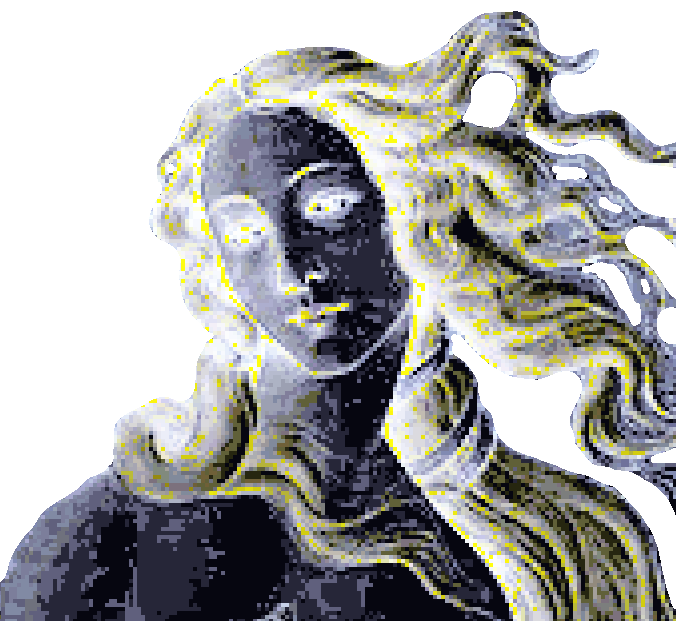 |
|
|
Sisters |
- Some scholars believe these two paintings were created as background scenery, for plays related to wedding celebrations in Milan, of
sisters Isabelle d'Este in 1490, and Beatrice
d'Este in 1491.
- It's not hard to imagine Leonardo drawing
in such a cartoon-like style, compared to his more formal
sfumato, especially for greeting card type memorials made
for
a joyful wedding event.
|
Sfumato is a painting technique that creates soft, hazy transitions between colors and tones, resulting in a delicate, smoky effect. It involves subtle blending of colors to eliminate harsh outlines and create a sense of depth and atmosphere. The term "sfumato" is derived from the Italian word "fumo," meaning smoke, which aptly describes the technique's characteristic haziness. (Assistant)
|
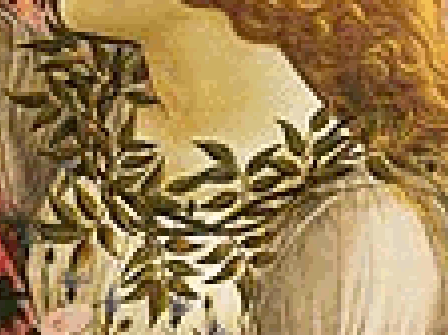
Spring |
- It may have been Leonardo's version of a Hallmark card
to the bride and groom, you never know.
- It's also been determined that both Birth of Venus
and Primavera depict different stages of
Neoplatonist thought, one being the virginal and the other the
pregnant spring.
- Which means it would be reasonable to
think that each of the sisters would receive one of the
paintings as a gift.
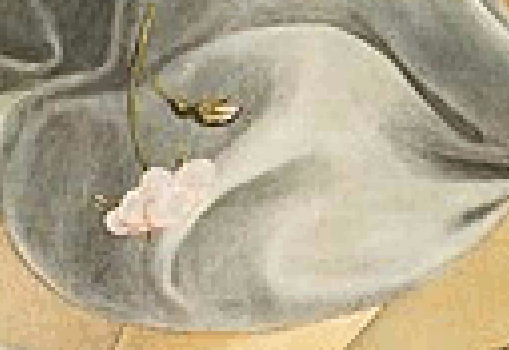
Pup |
- The two artists did have connections; as a young man Botticelli worked alongside a teenage
DaVinci in the workshop of the sculptor Andrea del Verrocchio.
Birth of Venus
Botticelli |
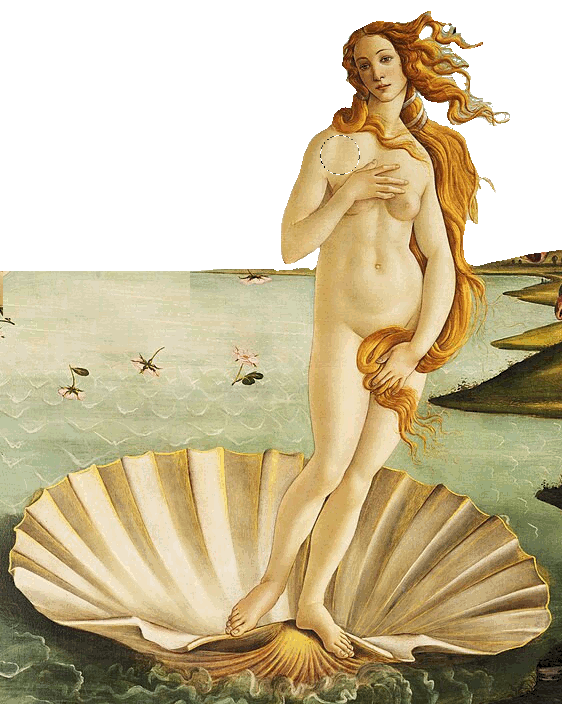
Dragon lady 'heir'
Isabelle
d' Este |
- Isabelle d' Este (1474-1539), is the identity of, the
floating figure of Venus.
- She was married to
Francesco II Gonzaga in 1490.
- More traditionally, to
many art historians,Venus represents Simonetta Cattaneo Vespucci who had died
14
years earlier and was a supposed lifelong love interest of
Botticelli's.
- She was oftentimes called his muse.
- There is no evidence that Botticelli ever met or painted Simonetta from life.
|
Botticelli’s hairstyle may be an invention, which makes sense, for it is there, between the locks, that he hid a coded message. You see, he painted those tufts as inverted flames, a motif symbolizing love, which aches like a burn. Botticelli flips the tufts because the poets of his time suggested that love, a divine gift, is fire descending from the heavens, like sun rays. (Emanuele Lugli)
|
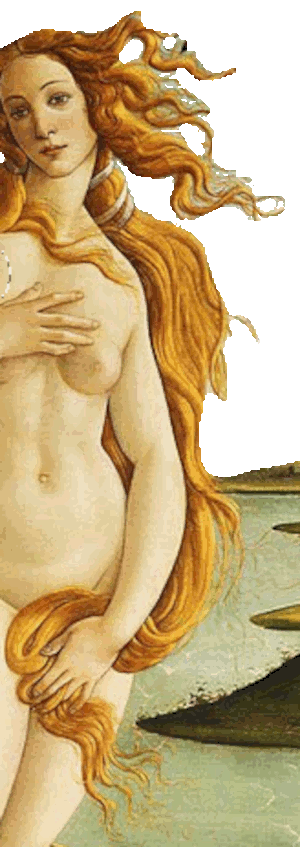
Dragon lady 'heir' |
- To the right, hidden in her tangles of hair, a subliminal snake, as big as a dragon.
- This symbol is the main element, in the Sforza family
coat-of arm's and they were one of Leonardo's main patrons.
Leda and the Swan
DaVinci |
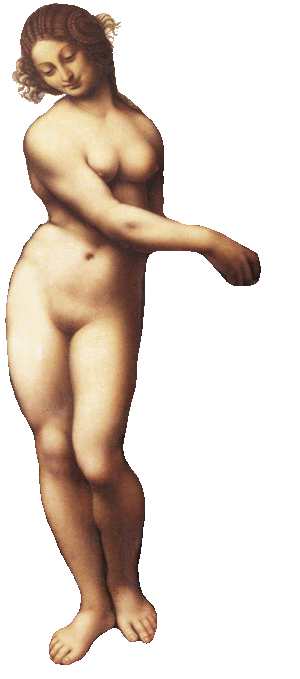
1505-1510 |
- DaVinci's Leda and the Swan is very similar
to Botticelli's Birth of Venus and they both were both painting
during the same period.
|
Comparing the figure of Venus to the figure in Leda and the Swan, it is obvious, these two paintings exhibit the same artistic style, of one artist; Leonardo
DaVinci, not Botticelli. (Sharron
Connelly, researchgate.net)
|
Mona Lisa
DaVinci |
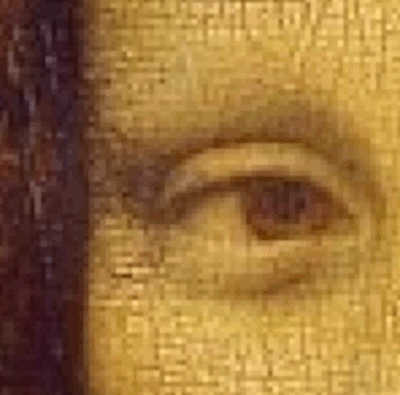
Isabella?
1503-1506 |
- In the current Catalogue raisonné of
Leonardo DaVinci, only Isabella d'Este is documented as a plausible alternative as the subject of Leonardo's
Mona Lisa, usually considered a portrait of Lisa del Giocondo.
- Evidence in favor of Isabella as the subject of the famous
Mona Lisa includes Leonardo's drawing
Isabella d'Este from 1499 and her letters of 1501–1506 requesting
a promised painted portrait from Leonardo.
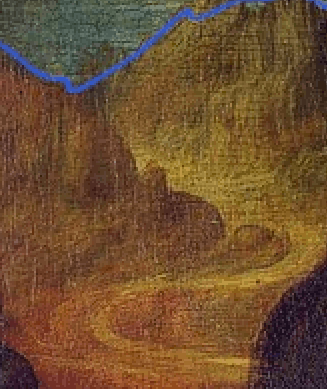
Mona view |
- Further arguments focus upon the mountains in the background indicating the native origin of the subject, and the armrest in the painting as a Renaissance symbol used to identify a portrait as that of a sovereign.
- The Louvre's reservation is that Isabella would be a 'blonde,'
a feature that exists only in the widely circulated but
uncertain representation in one painting called Isabella
in Black.
|
Women combed their hair every day — this is how they cleaned it — then braided and styled it. When they did wash their hair, it took a whole day. Noblewoman Isabella d’Este wrote in a letter (dated January 25, 1494) that her reply to her husband, Francesco II Gonzaga, was one day late because it took her that long to dry her head. While it may have been an excuse, it was a believable one. (Emanuele Lugli)
|
Isabella d'Este
DaVinci |
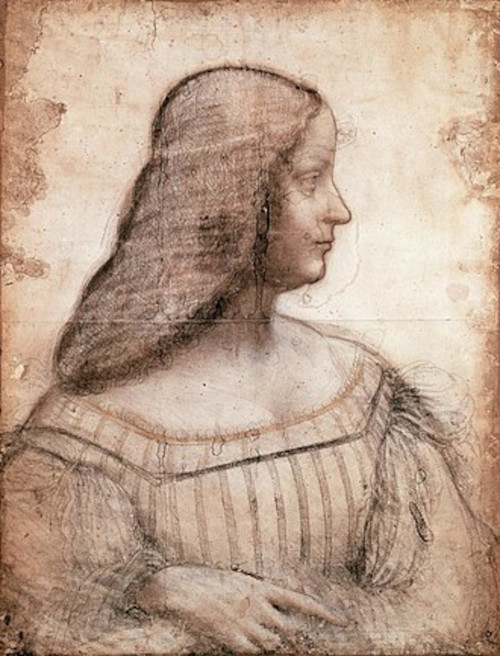
1499-1500 |
- Leonardo da Vinci's Portrait of Isabella d'Este is a drawing created around 1499-1500, depicting Isabella d'Este, the Marchioness of Mantua.
- While a drawing, there's evidence suggesting a painted
version may have existed, though it's either lost or never
completed.
- The drawing, currently in the Louvre, is notable
for its use of black and red chalk, and yellow pastel chalk on
paper.
|
It's considered a significant work in Leonardo's portraiture and a precursor to the Mona Lisa. (Assistant)
|
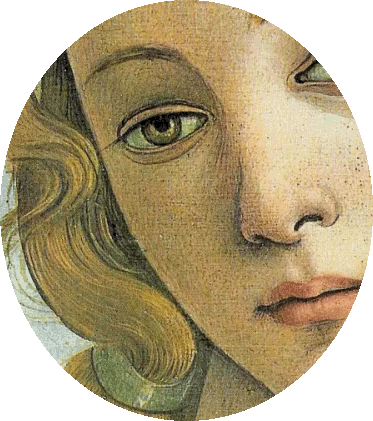
Isabella d'Este
again |
- Interestingly, it seemed that fellow artists had it out for Leonardo because Isabella d'Este's who owned an important art gallery, felt that
Sandro Botticelli and Andrea Mantegna were 'old school' and Leonardo was more modern.
- There seemed to be quite a bit of jealousy against Leonardo
from these two artists and apparently one of the reasons he left Florence for Milan in 1481.
The Parnassus
Mantegna |
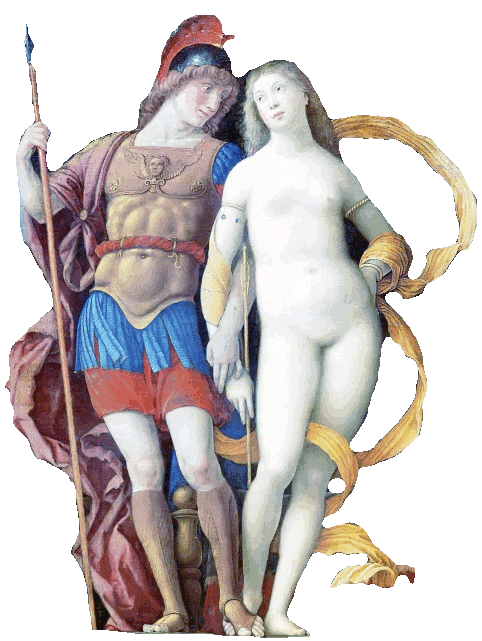
1496-1497
Isabella d'Este as Venus |
- The Parnassus is a painting by the Italian Renaissance painter Andrea
Mantegna (1431-1506),
created in 1497.
- It wasn't only Leonardo that they took their anger
out on, Mantegna mockingly painted Isabella d'Este's (Marchioness of Mantua) as Venus because he
was in a rage because of her views about his artwork which she
previously had always enjoyed.
- Isabella was widely sought as a model apparently.
|
Mantegna came up with the goods by making several tongue-in-cheek references to Leonardo in the Parnassus painting. The most obvious the knot attached to the bedpost and the cushion shaped as his famous cap.
(catchlight.blog)
|
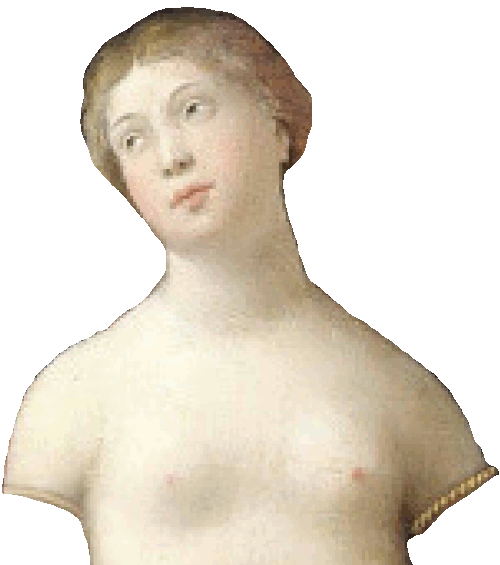
Venus de Milo |
- Isabella wanted Leonardo to paint her, which just
happened to enrage Mantegna all the more so he painted
her as a harlot.
- It's unclear if DaVinci painted her
because preliminary sketches were found so he was definitely
thinking about it.
- From Mantegna's came the allegory of Isabella d'Este as Venus and
her husband Francesco II Gonzaga as Mars.
|
After 1497, Mantegna was commissioned by Isabella d'Este to translate the mythological themes written by the court poet Paride Ceresara into paintings for her private apartment (studiolo) in the Palazzo Ducale. (Wikipedia)
|
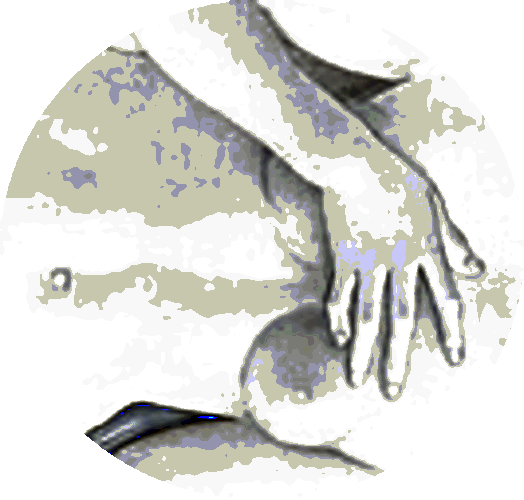
Man throwing stone apples |
-
Some say that Isabella d’Este, portrayed as a naked Venus,
is arm in arm with Piero di Lorenzo de’ Medici shown as Mars,
and not her husband.
- de' Medici had fled from Florence, and on his way to Venice visited the Marchioness
Isabella d’Este.
|
Isabella d’Este, who married Francesco II in 1490,
rapidly decided to create a studiolo in a tower of the
old Castello di San Giorgio. The work on this project
lasted more than twenty years. She entrusted Mantegna
with the first two canvases of the cycle, Parnassus
(1497) and Minerva (1502), but considering his work
out-of-date, she turned to the most famous painters of
the new generation.
(mini-site.louvre.fr)
|
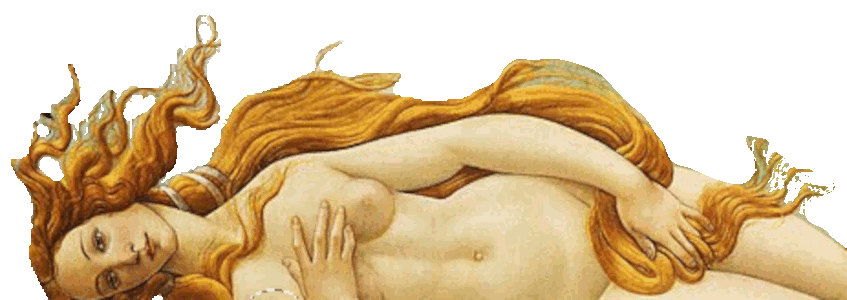
Isabella portrayed as harlot |
- Battista Fiera, a close friend of Mantegna,
wrote a witty poem that implyed that Isabella was cast as
Venus.
- Isabella started catching on when Fiera wrote a
note to her and told her he was sorry because he had not
recognized Mars as her husband, although she apparently still thought it was
flattery.
- Seems like there was quite a bit of jealousy
involved on Mantegua's part.
|
the rest he left unsaid.
(Battista Fiera)
|
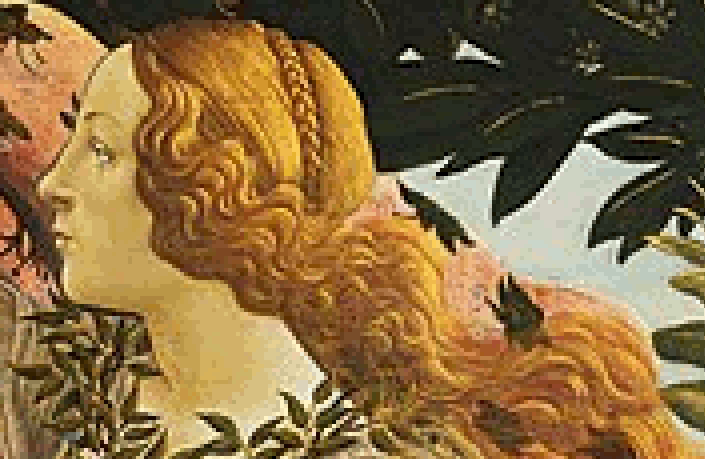
Beatrice d'Este |
- The figure on the right in the
Birth of Venus is Beatrice d'Este
(1475-1497), who holds the head of a subliminal dragon in the folds of the red scarf.
- She was the wife of Ludovico Sforza
and the Duchess of Milan from 1491-1497.
- Charles VIII and his cousin, Louis of Orléans were met by riots when Beatrice greeted them on September 11, 1494.
- Both performed French style 'kiss and touch' on Beatrice which riled the Italians
who did not appreciate.
|
With her determination and bellicose nature, she led the Milanese resistance against the French during the first of the Italian Wars. Her interventions repelled the Duke of Orléans who was on the verge of conquering Milan. (Wikipedia)
|

Beatrice d'Este
raised in Naples |
- The two sisters had a father that beheaded his wife and
then died of poisoning.
- After she and her sister were left
half-orphaned, King Ferrante (King Ferdinand I) of Naples, her grandfather on her mother's side, convinced her mother to leave both Beatrice and a newborn brother in Naples when she was 2.
- She was adopted by her grandfather.and lived there in
Duchy of Ferrara for 8 years.

Beatrice's life was cut short |
- Her new husband, Ludovico regarded her as a 15-year-old child
and unfortunately, she was just a political pawn.
- Political alliance between the Ferrarese house of Este and the Milanese house of Sforza.
- Her
father, Niccolo III, Signore di Ferrara, Modena e Reggio (1393-1441), considered her a disgrace because she wasn't a male.
- She was
reluctantly promised in marriage to Duke of Bari Ludovico
Maria Sforza (1452-1508), the Moor,
39, at age
10.
- Due to her age, the marriage was pushed back
to May 1490, because the Duke postponed several times.
- He was
already in a
relationship with Cecilia Gallerani, his mistress.
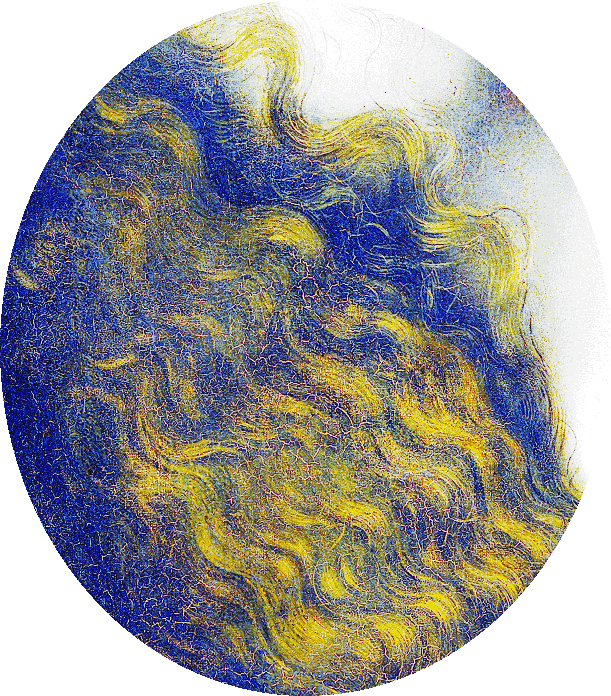
Milan burning |
-
Beatrice's life was cut short by death through childbirth, January 3, 1497, at the age of 22.
- Her funeral was one of the most lavish of Renaissance funerals
and she was buried in her finest golden robe.
- On the night of her death, the skies
over Milan were filled with firey flames.
Beatrice d'Este
DaVinci Circle |
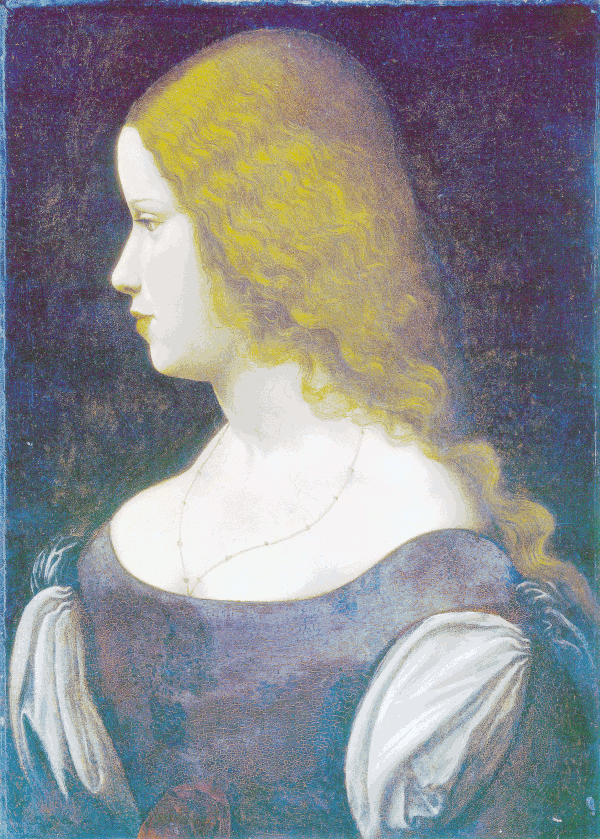
Leonardo
DaVinci, Public domain, via Wikimedia
Commons
1500 |
- Beatrice d'Este (1475-1497).
- This portrait came
from Leonardo's 'circle' so may have been his workshop.
-
Bianca Giovanna Sforza was
the Illegitimate daughter of Ludovico Sforza and her portrait
is often confused with Beatrice.
- Leonardo appears to have had no close relationships with women except for his friendship with Cecilia Gallerani and the two Este sisters, Beatrice and Isabella.
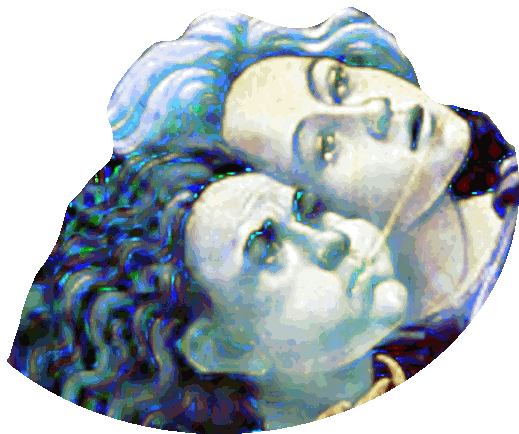
Medici Orsini |
- The two figures, flying in from the
left, are Lorenzo Medici, Botticelli's boss, and his wife Clarice Orsini.
-
Clarice and Lorenzo wed in 1469, after the marriage was arranged by Lorenzo's mother,
Lucrezia, who wanted her eldest son to marry a woman from a noble family to enhance the social status of the Medicis.
|
The political nature of her marriage meant that she
was often called upon by each side of her family to
influence the other. This included Lorenzo helping her
brother Rinaldo get selected as Archbishop of
Florence. She was also called on by others throughout
the area to support their requests to her husband.
People sought her support in easing taxes and
releasing family members from exile or prison. She would also use her network to gather information about political and military events away from where she was, including troop movements and battles. (Wikipedia)
|
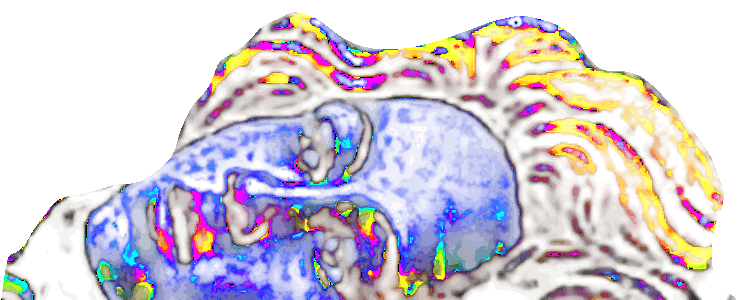
Mother of Pope Leo X |
- In March 1467, Lucrezia reported back to her husband Piero de’Medici about the potential alliance between the Medici and Orsini.
- Lucrezia’s letters clarify how important clothing and beauty was to the political and social movements of the Renaissance world.
- The Medici matriarch’s concern proved needless, as Clarice gave birth to
10 children, 6 survived into adulthood.
- One of Clarice’s sons
was Pope Leo X.
|
In the letter, Lucrezia segments the shy Clarice to her smallest attributes, describing her hair color, hands, and posture to Piero. Lucrezia wished to know whether the prospective adolescent bride seemed physically qualified for childbearing and furthering of Medicean lineage. Indeed, Lucrezia complains twice in the same letter that she could not get a clear look at Clarice’s body during her visit. (smarthistory.org)
|
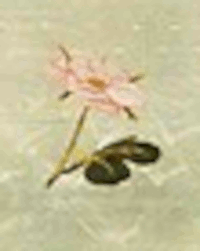
Milan 1491 |
- The Duke of Milan and Beatrice's
wedding in 1491 turned out to be the biggest event Leonardo
ever devised.
- Not only did he create the menu, entertainment and decoration, but he even designed what guests would wear, including their hats.
- Leonardo's ingenious dining room layout, which was one
long table where diners all sat on the same side was very
different than the typical circle that most tables were
arranged in.
|
Leonardo's involvement in wedding planning went beyond the visual spectacle. He also designed aspects like the menu, entertainment, and even the guests' attire. His innovative dining room layout, with guests seated along one side of a long table, was an idea he later utilized in his iconic painting The Last Supper. (Assistant)
|
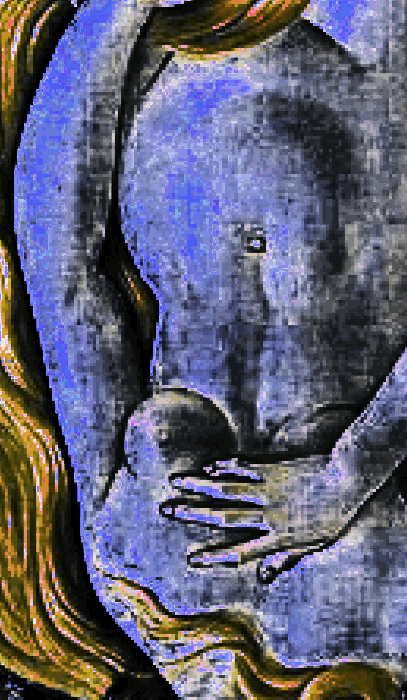
Picasso was here |
- Leonardo designed the wedding ceremony and
elaborate settings for several weddings and even had the
informal title of 'Master of Feasts and Banquets.'
- While at
the Sforza Court his tasks encompassed planning various celebrations, including weddings.
- He would oversee every detail, from the decorations and costumes to the special effects and stage sets.
|
Leonardo DaVinci was indeed involved in designing and orchestrating elaborate wedding ceremonies and settings during his time as a court artist and "Master of Feasts & Banquets". (Assistant)
|
Mystical Nativity
Botticelii |
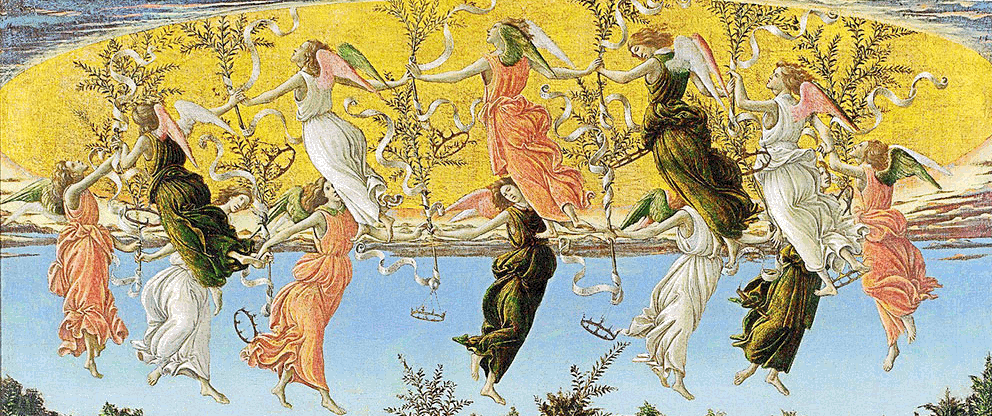
Golden polenta cake
|
-
DaVinci is credited with creating a spectacular 200-foot-long edible altar made of cake and polenta
presented in the same manner as pizza.
-
A 'polenta altar' isn't a standard term, but it refers to a
tradition where polenta is served on a large wooden board,
often with toppings and sauces, and shared by a group of
people.
- This creation was commissioned by Ludovico Sforza for his wedding to Beatrice d'Este, as a unique and extraordinary feature for the celebration.
|
Polenta is a dish of boiled cornmeal, originating in Northern Italy, and is a staple in Italian cuisine. It can be made with various grind sizes of cornmeal, from coarse to fine, and can be cooked into a creamy porridge or allowed to solidify into a loaf that can be baked, fried, or grilled. Polenta is often served as a base for stews, braised meats, or roasted vegetables. (Assistant)
|
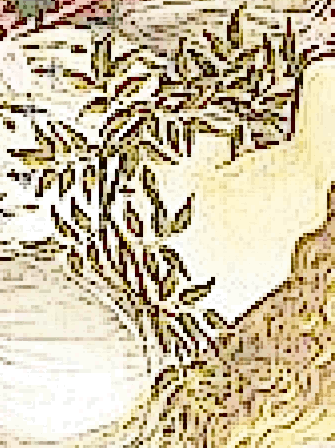
Farro wheat |
- While polenta, the Italian cornmeal dish, is now a staple, it wasn't always made with corn.
- In ancient Italy, a similar dish called "puls" was made from farro, millet, or chickpea flour.
- Corn, and therefore cornmeal, arrived in Europe after the Columbian Exchange in the 16th century.
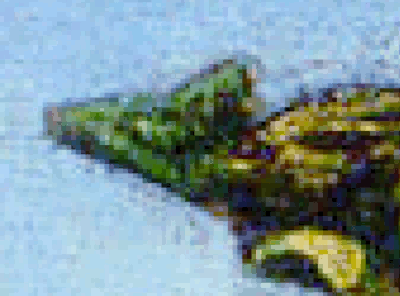
Rat
|
-
However, the story includes an unfortunate ending because rats ate the majority of the altar the night before the wedding, and it had to be recreated.
- The wedding was reportedly postponed to allow DaVinci time to craft a new altar.
|
Possibly the greatest feat to come out of
Da Vinci's stint as the Sforza’s Food and Beverage Manager was the Ultima Cena (‘Last Supper’) painting, arguable one of the world's most famous paintings. It was commissioned by the Duke Ludovico Sforza and curiously, the small vineyard with which Sforza paid Da Vinci for the Last Supper is located right next to the location where the painting finally came to rest (and where it can still be viewed today), in the Convent of Santa Maria delle Grazie in Milan. (la-tavola.it)
|

Footprint |
- Some claim this story isn't true but it's not hard to
imagine 300 guests or so going through this amount of food,
and it's doubtful that the 'rats' ate all of it, they
probably just walked through it.
- Or possibly it was
vermicelli mixed in similar to a type of Botticelli pasta or
sauce.
- Also the Chinese year of the rat included
Leonardo who was born in 1452.
|
Etymology. from Italian vermicelli "pasta similar to but thinner than spaghetti," literally, "little worms," from verme "worm," from Latin vermis "worm" — related to vermin. (Assistant)
|
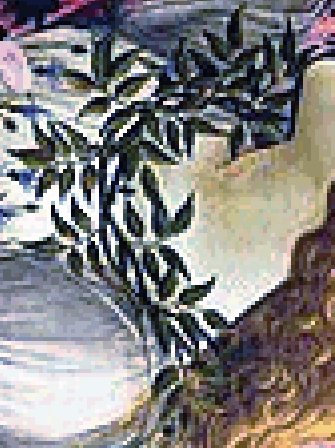
Neoplatonic
laurel wreath |
- Botticelli didn't just paint graceful figures, he encoded
Neoplatonic ideas about beauty as a reflection of the divine.
- The church may have ruled the surface, but beneath the
brushstrokes, Renassance artists like Botticelli and DaVinci
were part of a quiet revolution.
- That is why Botticelli's work is so similar to DaVinci's Baptism of Christ and is able to merge the
mythological and the evangelical in synergy with Florentine
neoplatonic philosophy.
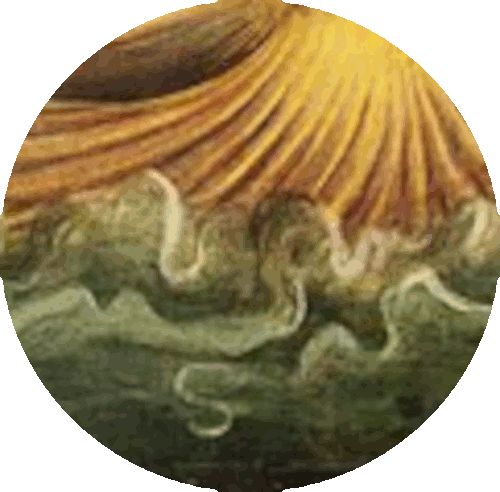
Vermicelli rises |
- The most confusing part;
DaVinci was a distinguished leader in the Neoplatonist Movement,
however, Botticelli was associated with the Neoplatonists only through
his 'earlier' paintings.
- For the most part, Botticelli was a Christian, as is the subject, of
many of his later paintings and his apparent devotion to
Dominican Friar Girolamo Savonarola who was busy burning
artwork that was not explicitly Christian.
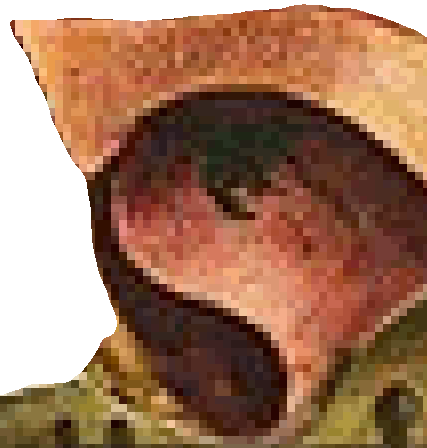
Red dragon roars |
- Botticelli was a devout follower of Savonarola; who instituted the burning of salacious art, in his
Bonfires of the Vanities in Florence.
- As a result of his association with Savonarola, Botticelli
eventually quit painting but the question that remains is
whether he became devout as he aged, but was not so much in his
youth.
- That does seem to happen with a lot of
individuals.
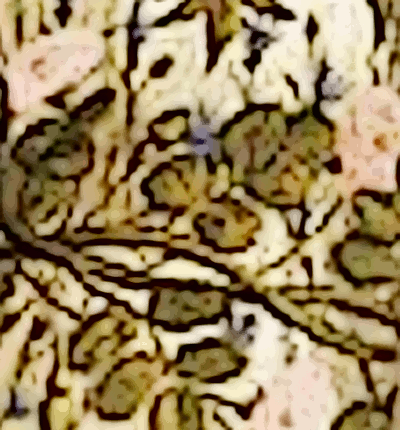
Divine connection with nature |
- Additionally, the Birth of Venus,
painted in 1485, is a Neoplatonic anthem to man's perfection and his divine connection with
nature.
- It was hidden away, because, if it had been in
Florence where Botticelli was painting, it would have been
burned as sacrilegious art in one of the Christian
Inquisition's.
- Some say that Botticelli painted on
canvas, not his normal media, because he could roll it up and
hide it for fear of being charged as a heretic, but really?
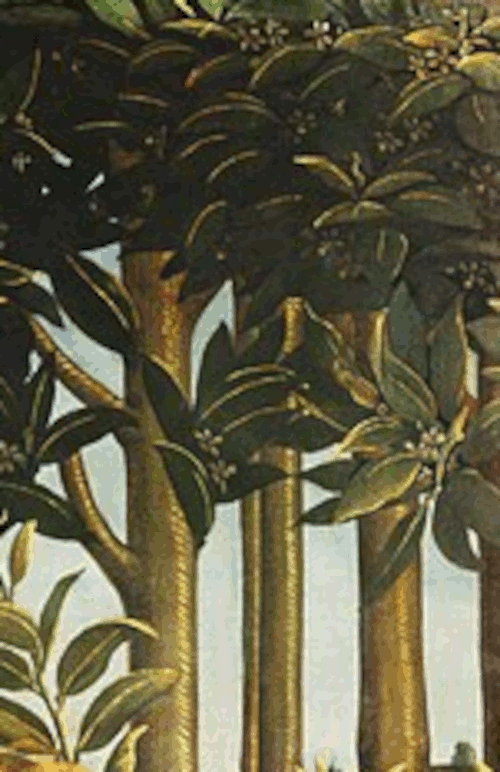
Beautiful landscape |
- Botticelli was quoted as saying he didn’t like painting landscapes, and that “by throwing a sponge soaked with different colors at a wall, one can make a spot in which a beautiful landscape can be seen.”
|
The above mentioned painter paints very bad
landscapes.
(Leonardo DaVinci)
|
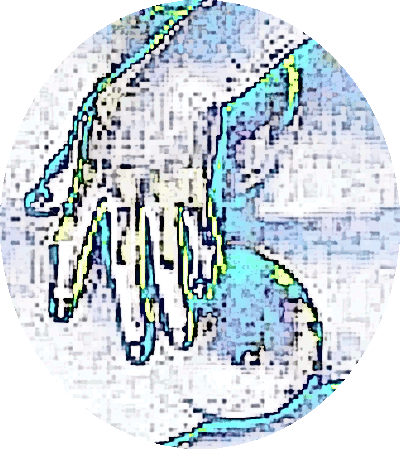
Magdalene |
- Ironically, Jesus' own teachings show very clearly that
he seemed to follow a Neoplatonic type of philosophy.
-
Although, Magdalene was the only one who understood, and the
only one of the Apostles willing to teach his true beliefs.
- The male Apostles were afraid of being rejected and scorned
by the congregation, afraid of looking 'crazy.'
|
In the Gospel of Mary Magdalene found in the Dead
Sea Scrolls, in the Savior's last sermon with his
disciples, he urges them not to look here and there
but only to turn within, such that those who turn to
their true spiritual selves will become liberated
further, that no external law will provide them
salvation and no amount of rule following or ritual of
any kind will substitute for the radical
self-understanding as an eternal spiritual being that
will return you to the divine after one's physical
body returns to its proper root source, that the
Magdalene has grasped this understanding while the
other apostles have not is apparent. (Esoterica)
|
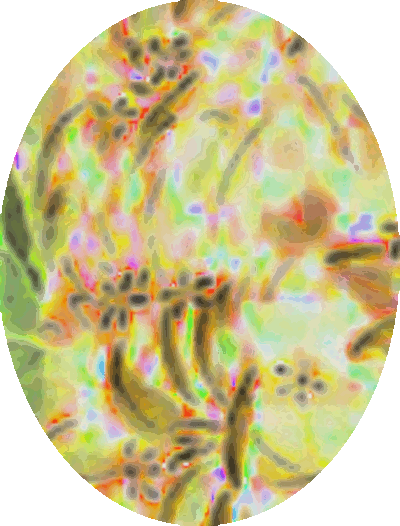
Tempera grassa |
- Another intriguing clue is that
the Birth of Venus is painted on canvas with tempera
grassa, a method pioneered by Leonardo DaVinci, not typically used by
Sandro Botticelli, if ever.
- Tiny black dots reveal that the image was transferred to
canvas, with a transparent paper pounce pattern stencil.
- There are too many dots, for the image to have been made, in the traditional manner,
and like other pieces of DaVinci's work, there are questions
about whether he created an optical image, photographically derived,
with the use of a camera obscura.
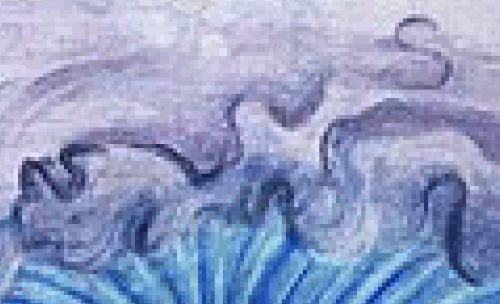
Vinci initials |
- Some have seen Leonardo's initials in the seafoam below
Venus.
- Plus it looks strangely like an infant in a cradle
with a bird wing on his chin.
Texan & Da Vinci Scholar, Sharron Connelly, introduced me to the idea that, Leonardo Da Vinci was involved in the creation of the Birth of Venus and Da Vinci's autographic initials appear in the foam of the flowing surf, beneath the main figure.
(researchgate.net)
|
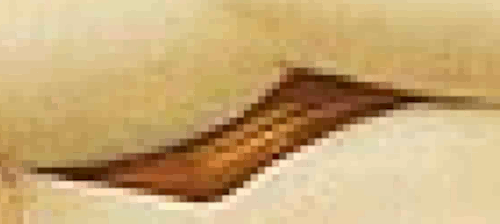
Bird |
- In his later years Leonardo wrote about his first memory as a child in his cradle.
- He was daydreaming in 1505 and taking notes at the time about the flight pattern of birds and the fork-tailed red kite (milvus vulgaris) in particular.
Writing like this so particularly about the kite
seems to be my destiny, since the first memory of my
childhood is that it seemed to me, when I was in my
cradle, that a kite came to me, and opened my mouth
with its tail, and struck me several times with its
tail inside my lips. (Leonardo DaVinci)
|
Venus and Mars
Botticelli |
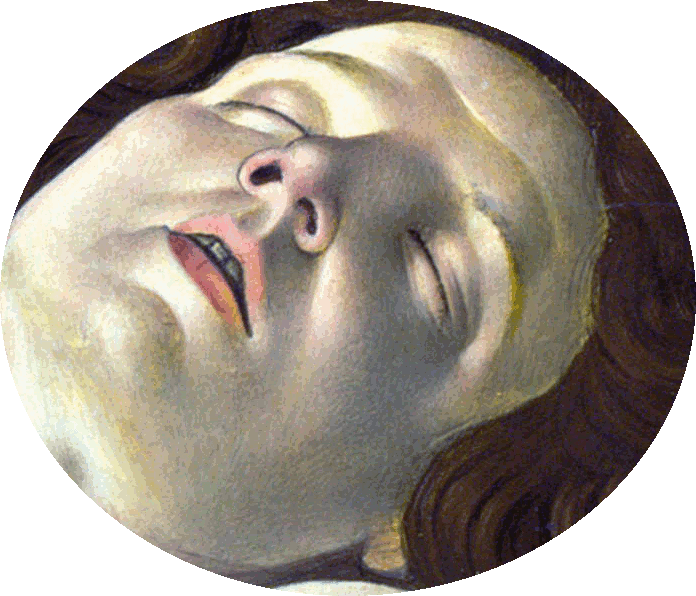
Leonardo DaVinci as Mars
with bird on
forehead |
- The four satyrs in Venus and Mars are Botticelli and his three brothers, Giovanni, Simone and Antonio.
- They are teasing and tempting the sleeping figure of Mars
(Leonardo DaVinci) and form the group of three demons clinging to the ‘damned man’ alongside the trumpeter.
- Leonardo was called a 'fallen angel' because of an
unsuccessful jump he took off a hilltop with one of his
inventions.
|
Another motif associated with Leonardo is the monkey and bird. It’s not the first time Botticelli has borrowed this motif from Leonardo’s painting of The Annunciation. In this instance, the bird is the figure of Repentance.
(catchlight.blog)
|
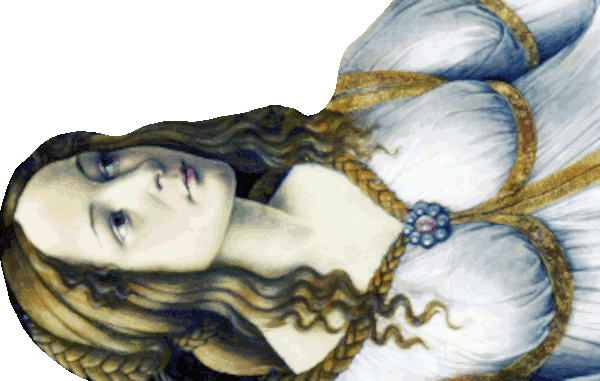
Iron Maiden |
- Venus here is a chaste version, the married Venus that is also found in
Botticelli's Primavera, dressed, enlocked in her gown.
- This promotes the ideal of marital love because she gives her
body only to her husband.
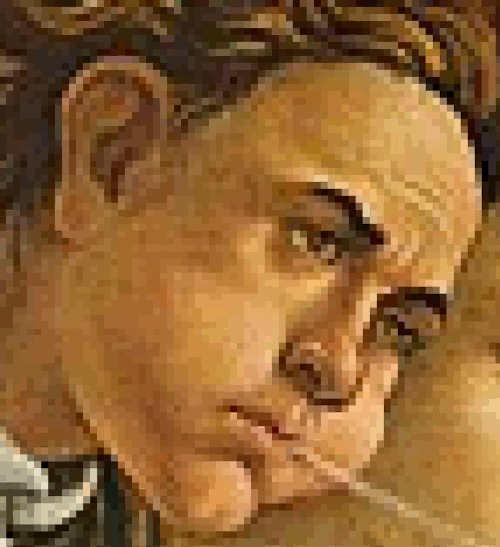
The damned man |
- A ‘fallen angel’ motif representing Leonardo can be
found in the Birth of Venus and was a reference that ties to
Botticelli's Venus and Mars painting where the three small
figures are teasing and taunting Mars, known as Leonardo DaVinci, the damned man.
Adoration of the Magi
Botticelli |
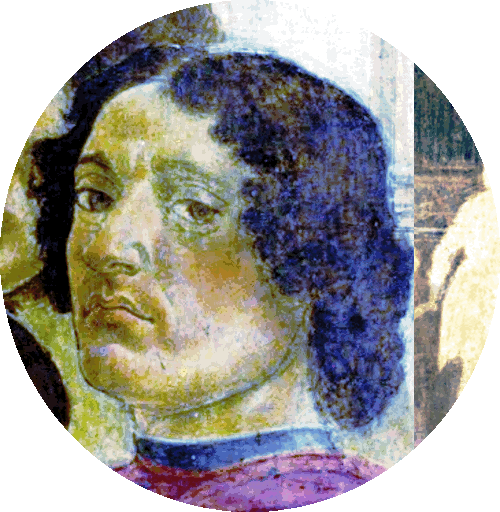
Shady character |
- Botticelli's Adoration of the Magi painting has been dated as 1475,
although Giuliano Medici, one of the main characters, wasn't murdered until 1478, it appears that
Botticelli's date should really be 1480.
- There is other
evidence that the date should be pushed back to 1481 because
of elements from DaVinci that Botticelli incorporated in his
version.
- So here is more confusion over the apparent
intertwining of Botticelli and Davinci, who's copying who?
- Or who is who?
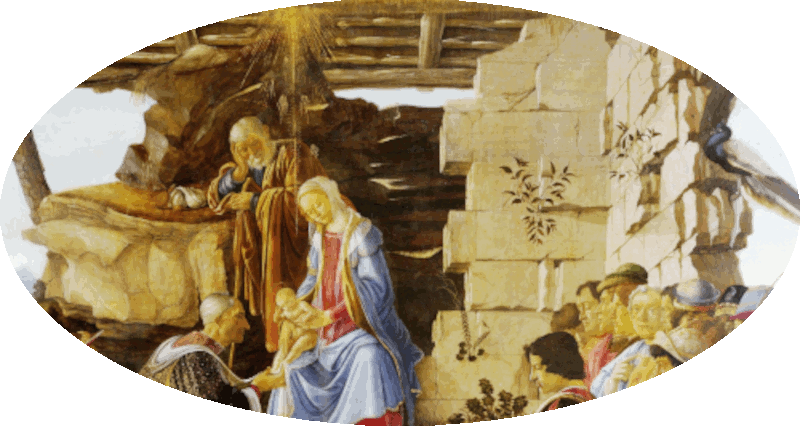
Sphinx stones |
- Th right side of the stone wall represents the sejant erect heraldic lion
which is the symbol of Florence known as the Marzocco.
-
It is placed alongside the infant Jesus and symbolizes the sacrificial Lamb of God, it becomes the Lion and Lamb peace symbol.
- Sculpted from the rock shelf which Joseph is leaning on
can be seen a head representing Leonardo
DaVinci.
- When this is merged with the lion feature, it produces a sphinx-like form of half-man and half-lion.
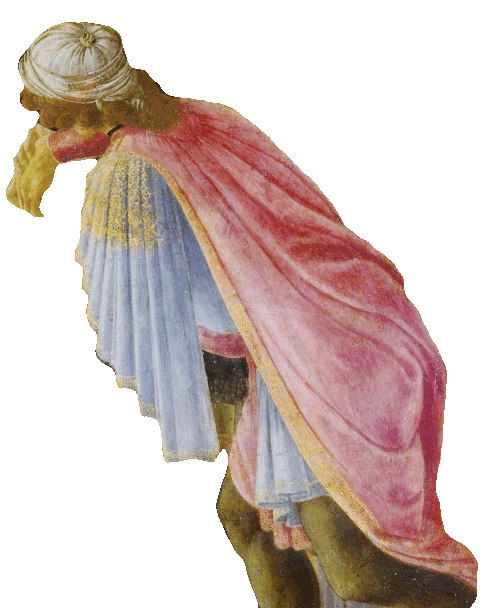
Leonardo as bird with wing |
- DaVinci was a favorite satirical target for Botticelli
and is portrayed with his protective winged left arm of God in Adoration of the Magi.
- Leonardo was often shown as a bird wearing rose pink and
here he is wearing a winged cloak this color, with one foot
hidden behind a curtain, like a bird perched on one leg.
- Of course, he was known to often wear this color and
this has been documented.
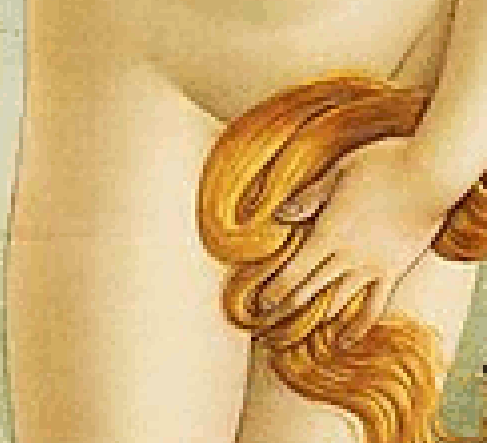
Hidden |
- But there are questions remaining; was Isabella
d'Este really so loved and hated by all these male artists?
- Why was Leonardo the brunt of so many Botticelli jokes?
- Were they
one and the same person?
- So many of these artists would
travel from city to city and use different names to sign their
work, especially unknown young artists.
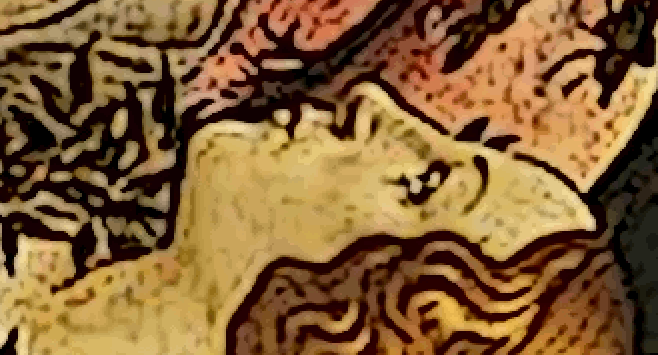
Resting |
- If they signed
them at all, Botticelli only signed one painting.
- The
name Botticelli itself
was a nickname (little barrel), not his birth name.
-
In Italian, barrel translates as la canna
cane, barrel, rod, reed, pipe, canna.
- It
does seems possible that DaVinci was Botticelli and he used
all the 'jokes' against himself as lively advertising.
-
We'll keep connecting up the dots.
|
In Italian, "botti" can mean either "barrels" or "fireworks," depending on the context. It's the plural form of "botte" (barrel) and "botto" (a bang, crack, or shot). When referring to New Year's Eve celebrations, "botti" specifically means fireworks,
(Assistant)
|
|
|

